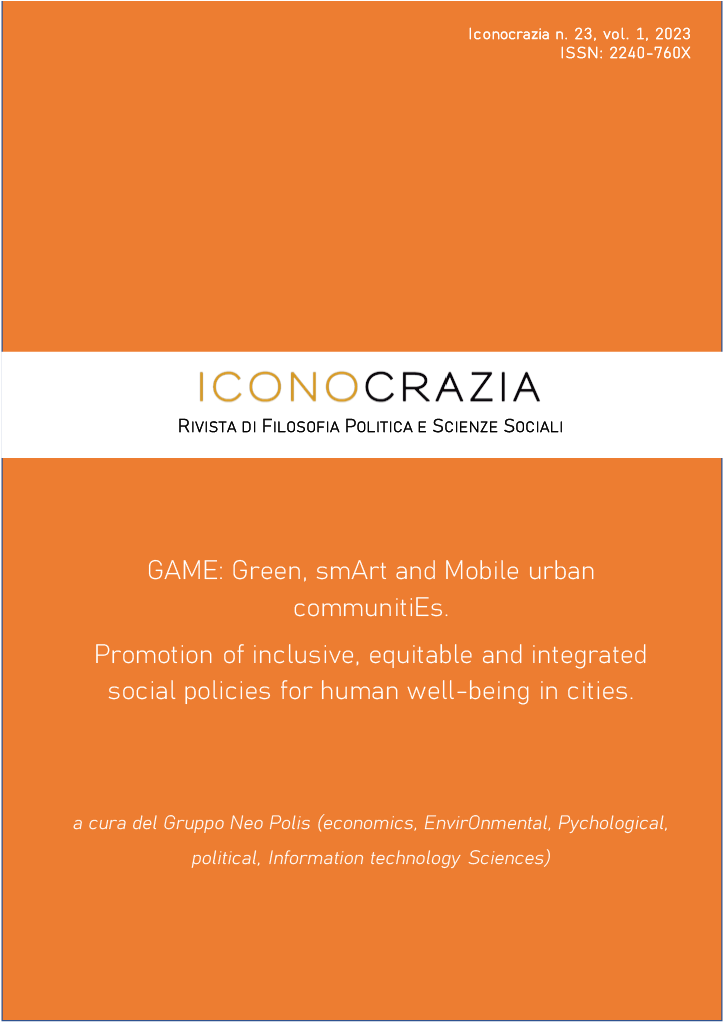Social Capital and Geriatric Depression during Ageing: could this association be mediated by Perceived Social Support and Perceived Social Cohesion among Neighbors?
DOI:
https://doi.org/10.15162/2240-760X/1842Parole chiave:
Social capital, geriatric depression, ageing, social cohesion, neighborhoodAbstract
The main aim of the present study is to examine the link between social capital and the geriatric depression symptoms during ageing, in addition to analysis of the role of the perceived social support and social cohesion in the aforementioned relationship. It was hypothesized that older adults who can have access to a larger social capital than others experience less geriatric depression symptoms. Furthermore, it is hypothesized that the effect of social capital on the symptoms of geriatric depression is due to perceived social support and social cohesion among neighbors. A sample of 588 older adults (50-90 years old), filled out self-reported measures. Geriatric depression symptoms were measured using the Geriatric Depression Scale (GDS). The Functional Social Support (FSSQ) and the Social Cohesion and Trust Scale were used to assess perceived social support and perceived social cohesion, respectively. These results showed that the social capital may be a protective factor against geriatric depression as long as the scores of perceived social support. Moreover, these findings may provide relevant insights for developing age-friendly urban communities improving social contact opportunities and social policies to promote well-being during ageing.
Riferimenti bibliografici
Ashida, S., & Heaney, C. A. (2008). Differential associations of social support and social connectedness with structural features of social networks and the health status of older adults. Journal of aging and health, 20(7), 872-893.
Bai, Z., Xu, Z., Xu, X., Qin, X., Hu, W., & Hu, Z. (2020). Association between social capital and depression among older people: evidence from Anhui Province, China. BMC public health, 20, 1-11.
Barbabella, F., Cela, E., Socci, M., Lucantoni, D., Zannella, M., & Principi, A. (2022). Active ageing in Italy: A systematic review of national and regional policies. International journal of environmental research and public health, 19(1), 600.
Boerio, P., Garavaglia, E., & Gaia, A. (2021). Active ageing in Europe: are changes in social capital associated with engagement, initiation and maintenance of activity in later life?. Ageing & Society, 1-19.
Bordieu, P. (1986). The Forms of Capital'In: Richardson. Handbook of Theory and. Brink, T. L., Yesavage, J. A., Lum, O., Heersema, P. H., Adey, M., & Rose, T. L. (1982). Screening tests for geriatric depression. Clinical gerontologist, 1(1), 37- 43.
Brunie, A. (2009). Meaningful distinctions within a concept: Relational, collective, and generalized social capital. Social science research, 38(2), 251-265.
Cao, J., & Rammohan, A. (2016). Social capital and healthy ageing in Indonesia. BMC Public Health, 16(1), 1-14.
Cao, W., Li, L., Zhou, X., & Zhou, C. (2015). Social capital and depression: evidence from urban elderly in China. Aging & mental health, 19(5), 418-429.
Chipps, J., & Jarvis, M. A. (2016). Social capital and mental well-being of older people residing in a residential care facility in Durban, South Africa. Aging & mental health, 20(12), 1264-1270.
Choi, N. G., Kim, J., DiNitto, D. M., & Marti, C. N. (2015). Perceived social cohesion, frequency of going out, and depressive symptoms in older adults: examination of longitudinal relationships. Gerontology and Geriatric Medicine, 1, 2333721415615478.
Cohen, S. E., & Syme, S. I. (1985). Social support and health. Academic press.
Coleman, J. S. (1994). Foundations of social theory. Harvard university press.
Cramm, J. M., Van Dijk, H. M., & Nieboer, A. P. (2013). The importance of neighborhood social cohesion and social capital for the well being of older adults in the community. The Gerontologist, 53(1), 142-152.
De Blasio G., Sestino P. (eds.) (2011), Il capitale sociale, Donzelli, Roma.
Fulkerson, G. M., & Thompson, G. H. (2008). The evolution of a contested concept: A meta‐analysis of social capital definitions and trends (1988–2006). Sociological Inquiry, 78(4), 536-557.
Galeoto, G., Sansoni, J., Scuccimarri, M., Bruni, V., De Santis, R., Colucci, M., ... & Tofani, M. (2018). A psychometric properties evaluation of the Italian version of the geriatric depression scale. Depression research and treatment, 2018.
Gariepy, G., Honkaniemi, H., & Quesnel-Vallee, A. (2016). Social support and protection from depression: systematic review of current findings in Western countries. The British Journal of Psychiatry, 209(4), 284-293.
Greenberg, S. A. (2007). How To try this: The Geriatric Depression ScaleShort Form. AJN The American Journal of Nursing, 107(10), 60-69.
Hamano, T., Yamasaki, M., Fujisawa, Y., Ito, K., Nabika, T., & Shiwaku, K. (2011). Social capital and psychological distress of elderly in Japanese rural communities. Stress and Health, 27(2), 163-169.
Han, K. M., Han, C., Shin, C., Jee, H. J., An, H., Yoon, H. K., ... & Kim, S. H. (2018). Social capital, socioeconomic status, and depression in community-living elderly. Journal of psychiatric research, 98, 133-140.
Hanifan, L. J. (1916). The rural school community center. The Annals of the American Academy of Political and Social Science, 67(1), 130-138.
Holt-Lunstad, J., Smith, T. B., Baker, M., Harris, T., & Stephenson, D. (2015). Loneliness and social isolation as risk factors for mortality: a meta-analytic review. Perspectives on psychological science, 10(2), 227-237.
Holt-Lunstad, J. (2021). Loneliness and social isolation as risk factors: The power of social connection in prevention. American Journal of Lifestyle Medicine, 15(5), 567-573.
Hosseini, F. S., Sharifi, N., & Jamali, S. (2021). Correlation anxiety, stress, and depression with perceived social support among the elderly: a cross-sectional study in Iran. Ageing International, 46(1), 108-114.
Julien, C. (2015). Bourdieu, social capital and online interaction. Sociology, 49(2), 356-373.
Kawachi, I., Kennedy, B. P., Lochner, K., & Prothrow-Stith, D. (1997). Social capital, income inequality, and mortality. American journal of public health, 87(9), 1491- 1498.
Kim, B. J., Auh, E., Lee, Y. J., & Ahn, J. (2013). The impact of social capital on depression among older Chinese and Korean immigrants: similarities and differences. Aging & mental health, 17(7), 844-852.
Lin N. (1999) Building a network theory of social capital. Connections 22(1): 28–51.
Id. (2001) Social Capital: A Theory of Social Structure and Action. New York: Cambridge University Press.
Loury, G. C. (1977). A dynamic theory of racial income differences. Women, minorities, and employment discrimination. PA Wallace and
AM La Mond. Lexington, MA.
Nyqvist, F., & Forsman, A. K. (Eds.). (2015). Social capital as a health resource in later life: the relevance of context (Vol. 11). Springer.
Nyqvist, F., Forsman, A. K., Giuntoli, G., & Cattan, M. (2013). Social capital as a resource for mental well-being in older people: A systematic review. Aging & mental health, 17(4), 394-410.
Parmelee, P. A., Lawton, M. P., & Katz, I. R. (1989). Psychometric properties of the Geriatric Depression Scale among the institutionalized aged. Psychological Assessment: A Journal of Consulting and Clinical Psychology, 1(4), 331.
Patil, B., Shetty, N., Subramanyam, A., Shah, H., Kamath, R., & Pinto, C. (2014). Study of perceived and received social support in elderly depressed patients. Journal of Geriatric Mental Health, 1(1), 28.
Sampson, R. J., Raudenbush, S. W., & Earls, F. (1997). Neighborhoods and violent crime: A multilevel study of collective efficacy. science, 277(5328), 918-924.
Schulman, M. D., & Anderson, C. (1999). The dark side of the force: a case study of restructuring and social Capital 1. Rural sociology, 64(3), 351-372.
Sun, Q., & Lu, N. (2020). Social capital and mental health among older adults living in urban China in the context of COVID-19 pandemic. International journal of environmental research and public health, 17(21), 7947.
Ten Bruggencate, T. I. N. A., Luijkx, K. G., & Sturm, J. (2018). Social needs of older people: A systematic literature review. Ageing & Society, 38(9), 1745-1770. The Jamovi Project (2023). jamovi (Version 2.3) [Computer Software]. Retrieved from https://www.jamovi.org
Unies, N. (Ed.). (2003). Political declaration and Madrid international plan of action on ageing. UN.
United Nations. (2020). World population ageing 2020 highlights: Living arrangements of older persons.
World Health Organization. (2002). Active ageing: A policy framework (No. WHO/NMH/NPH/02.8). World Health Organization.
Young, A. F., Russell, A., & Powers, J. R. (2004). The sense of belonging to a neighbourhood: can it be measured and is it related to health and well being in older women?. Social science & medicine, 59(12), 2627-2637.







